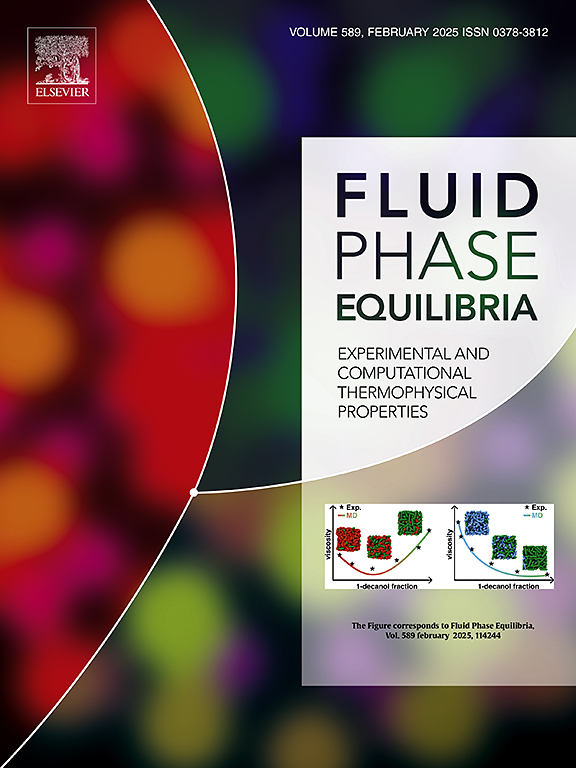Assessment of dissociation enthalpies of methane hydrates in the absence and presence of ionic liquids using the Clausius-Clapeyron approach
IF 2.8
3区 工程技术
Q3 CHEMISTRY, PHYSICAL
引用次数: 0
Abstract
The Clausius-Clapeyron (CC) equation is generally preferred to obtain dissociation enthalpies (ΔH) of hydrate-forming systems due to its ease of use. The application of other direct and indirect methods becomes more problematic if complex additives such as ionic liquids (ILs) are also present in the system. In this work, around 400 equilibrium data points for methane hydrates in the presence of over 80 ILs were collected from the literature in the temperature and pressure ranges of (272.10 – 306.07) K and (2.48 – 100.34) MPa, respectively. The ΔH of methane hydrates in the absence and presence of ionic liquids (ILs) have been calculated using the CC equation. The compressibility factor (z), required to calculate ΔH at each phase equilibrium condition has been obtained from three different approaches viz., Peng-Robinson (PR) equation of state, Soave-Redlich-Kwong (SRK) equation of state and Pitzer (Pz) correlation. The results were compared to the experimentally reported dissociation enthalpy (54.5 ± 1.5 kJ.mol−1) of methane hydrates. The role of the compressibility factor along with the slope of the equilibrium data set and the temperature/pressure range in determining the outcome of the CC equation has been discussed. The effect of molar mass, molar volume, and hydrate suppression temperature of the ILs on the ΔH of methane hydrates has been explored. The tested ILs do not show a systematic and significant influence on enthalpies, rather they show a large scattering in the ΔH values, which might mask any existing subtle effect of the ILs on the dissociation enthalpies. Therefore, this approach should be dealt with care to obtain molecular-level insights.
利用克劳修斯-克拉皮隆方法评估无离子液体和有离子液体时甲烷水合物的解离焓
克劳修斯-克拉皮隆(CC)方程由于易于使用,通常被优先用于获取水合物形成体系的解离焓(ΔH)。如果体系中还存在离子液体(IL)等复杂添加剂,则其他直接和间接方法的应用就会变得更加困难。在这项工作中,从文献中收集了约 400 个甲烷水合物在 80 多种 IL 存在下的平衡数据点,温度和压力范围分别为 (272.10 - 306.07) K 和 (2.48 - 100.34) MPa。使用 CC 方程计算了没有离子液体 (IL) 和有离子液体 (IL) 时甲烷水合物的 ΔH。计算每个相平衡条件下 ΔH 所需的可压缩因子 (z) 是通过三种不同的方法获得的,即彭-罗宾逊 (PR) 状态方程、索夫-雷德里希-邝 (SRK) 状态方程和皮策 (Pz) 相关性。研究结果与实验报告的甲烷水合物解离焓(54.5 ± 1.5 kJ.mol-1 )进行了比较。讨论了可压缩因子、平衡数据集斜率和温度/压力范围在决定 CC 方程结果中的作用。还探讨了 IL 的摩尔质量、摩尔体积和水合物抑制温度对甲烷水合物 ΔH 的影响。测试结果表明,ILs 对焓值的影响并不系统且不明显,相反,它们在 ΔH 值上表现出很大的分散性,这可能会掩盖 ILs 对解离焓值的任何微妙影响。因此,应谨慎处理这种方法,以获得分子层面的见解。
本文章由计算机程序翻译,如有差异,请以英文原文为准。
求助全文
约1分钟内获得全文
求助全文
来源期刊

Fluid Phase Equilibria
工程技术-工程:化工
CiteScore
5.30
自引率
15.40%
发文量
223
审稿时长
53 days
期刊介绍:
Fluid Phase Equilibria publishes high-quality papers dealing with experimental, theoretical, and applied research related to equilibrium and transport properties of fluids, solids, and interfaces. Subjects of interest include physical/phase and chemical equilibria; equilibrium and nonequilibrium thermophysical properties; fundamental thermodynamic relations; and stability. The systems central to the journal include pure substances and mixtures of organic and inorganic materials, including polymers, biochemicals, and surfactants with sufficient characterization of composition and purity for the results to be reproduced. Alloys are of interest only when thermodynamic studies are included, purely material studies will not be considered. In all cases, authors are expected to provide physical or chemical interpretations of the results.
Experimental research can include measurements under all conditions of temperature, pressure, and composition, including critical and supercritical. Measurements are to be associated with systems and conditions of fundamental or applied interest, and may not be only a collection of routine data, such as physical property or solubility measurements at limited pressures and temperatures close to ambient, or surfactant studies focussed strictly on micellisation or micelle structure. Papers reporting common data must be accompanied by new physical insights and/or contemporary or new theory or techniques.
 求助内容:
求助内容: 应助结果提醒方式:
应助结果提醒方式:


